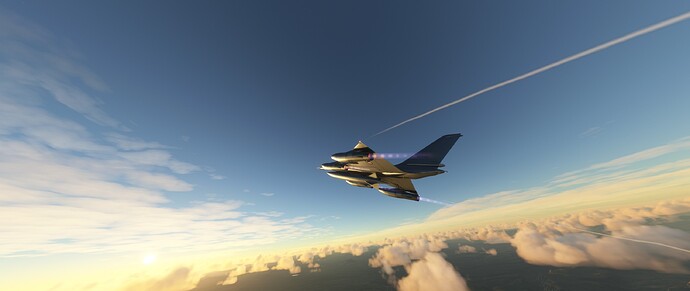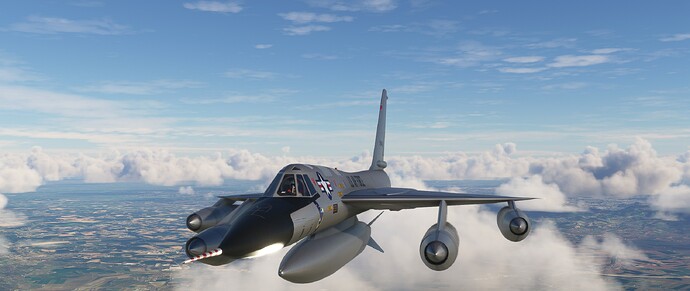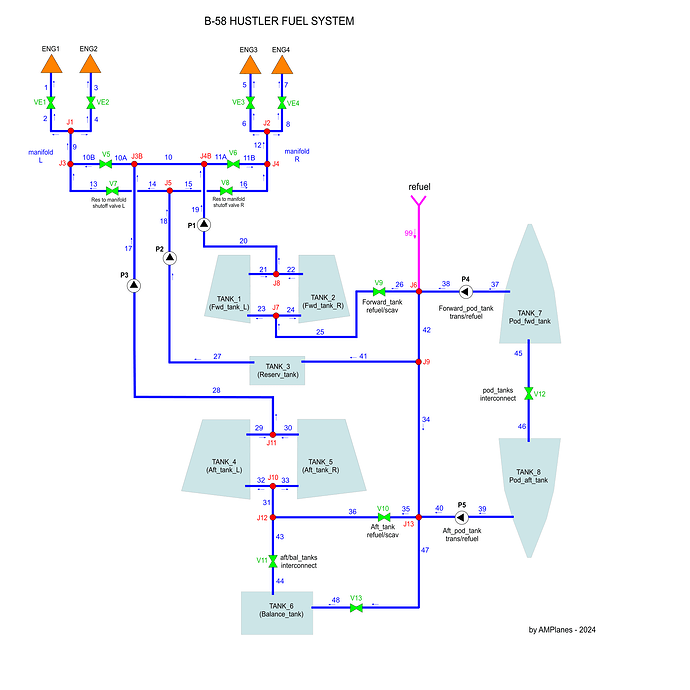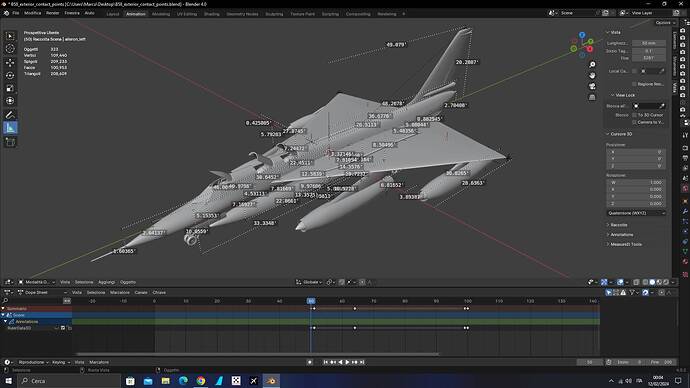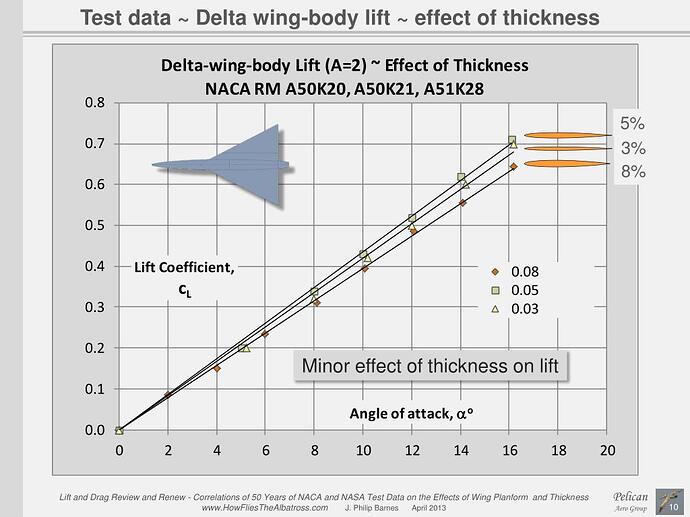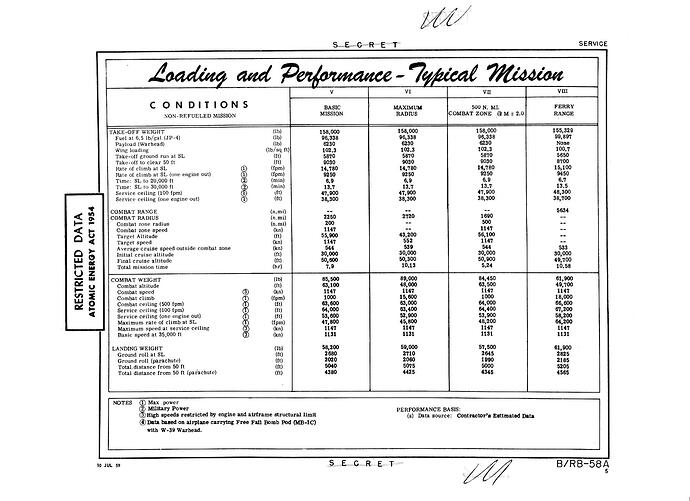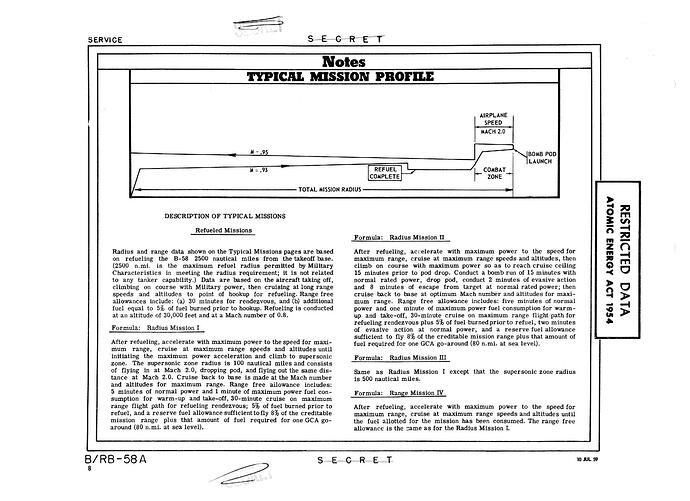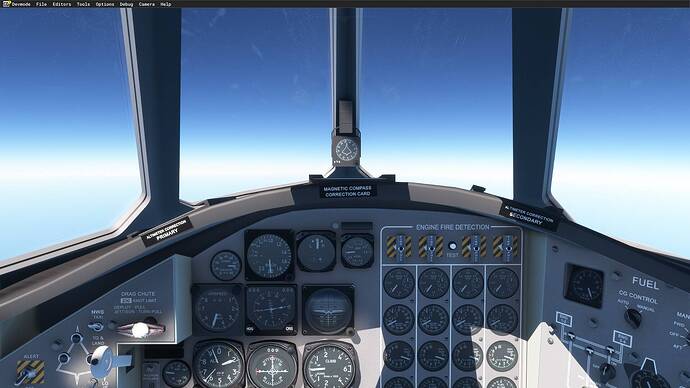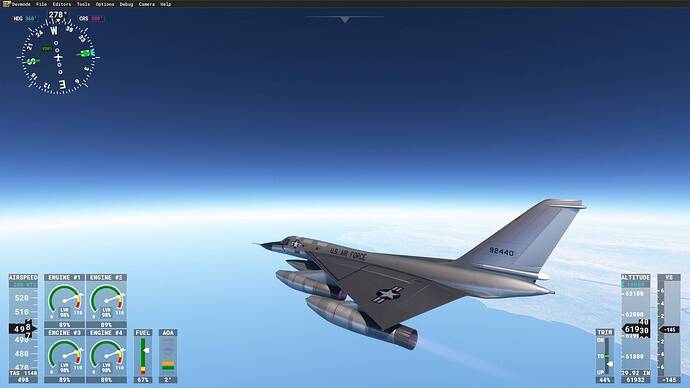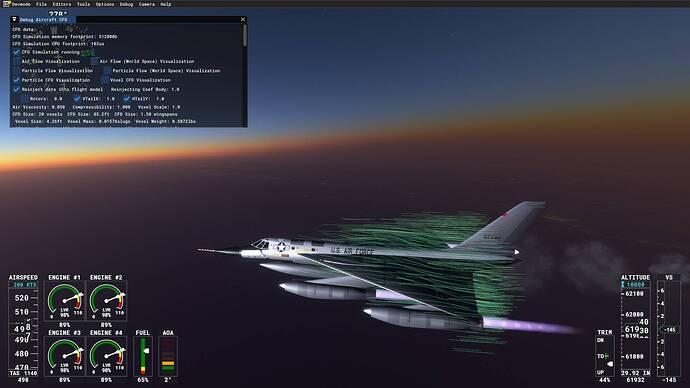Wow, very interesting and impressive airplanes.
I found a beautiful model of the Shinden on ArtStation,
https://www.artstation.com/artwork/xJwQyO
by Iakov Aizenberg, it looks amazing! And there is also a model
of the Dornier Do 335… it could be amazing to start from these
models and make them working on MSFS!
Don’t get carried away, you have 3 to finish first ![]()
Yeah, three are more than enough for the moment! ![]()
Some updates incoming!
Many little (and not little) things have been fixed, improved or added.
The most important news are that @Marcoflyer68 has done a great Job on the flight model and on the engines, and now the plane behaves much more accurately as the real plane did. Some work to be done yet, but a lot of issues solved.
Probably he will post some technical infos and some images of the aerodynamics forces and vectors from the simulator. I saw many of them and they are stunning.
I added afterburners effects, and vortex trails, and other things.
The fuel system is quite complicated, and it is very important to me to have the fuel panel working properly on the tanks, on the pumps and the valves as they are indicated on the diagram on the right side of the cockpit.
Now the controls work fine, but there are still other things to fix.
By the way… this kind of diagram depicting the fuel system is very useful to write the lines of the flight_model.cfg where the fuel system is described only by text rows.
I find it effective and makes the connections and flow directions clearer to understand and check. It would be beautiful to have some code converting the text lines into a diagram to verify if everything is ok, but for the moment this is beyond the purposes of my work. If someone has any suggestion I’ll be happy to listen and try.
Truly incredible work! Looking to flying it - when it’s ready.
Greetings -
following @Airmax514 update, let me share some clues on the development of the flight model for his gorgeous B-58 Hustler
First of all, was necessary to collect as much technical documentation as possible from open sources in Internet. Nowadays the once restricted documents are accessible, such as the authentic Flight Manual and J79 Engine Manual, Maintenance Manual and Illustrated Part List.
Also magazine articles, featuring interviews with the pilots that flew the B-58 during her operational career, are invaluable to gain some ‘feeling’ of what could have been to pilot such a fast and heavy bomber.
Interestingly, several pilots stated that the B-58 was a pleasant airplane to fly, stable throught the flight envelope, responsive at controls and with brutal performances.
I think the accidents that doomed the B-58 service were mostly due to the unforgiving speed limitations rather than controllability or stability. The B-58 was a heavy and very fast airplane with almost no margins for errors at the (relatively) low speed for approach and at the extreme speeds and altitude in excess of M2.0 and 64.000 ft
The first development step I took (as for the XB-70 Valkyrie) was to include in the flight model and engines CFG the exact data derived from the technical documentation. These includes aircraft geometry and engines performances.
I used the same delta wing characteristics developed for the XB-70 (derived from published NACA reports) with some variations due to differences between the two wings platforms. That model proved to be effective also for the B-58.
With the current flight model, is completely possible to fly the published flight envelope according to the non-refueled mission profile
I have yet to fine-tune the engine fuel consumption, this will be my next task for fine-tuning the performances
I have implemented all the advanced features allowed by MSFS:
- fully CFD aerodynamic model
- lateral drag coefficient for fuselage
- adverse yaw do to aileron differential deflection
- progressive stall to simulate (at least to a certain extent) the delta wing vortex lift
- controlled lateral forces during ground roll
- fully supersonic variable intake
- J79 brutal acceleration with two-stages afterburner
In its present state, the B-58 must be flown with all-time attention to speeds and throttle, as it is to be expected from such a high-perfomance airplane; still, I assure you can fly the complete flight envelope from takeoff to 64000 ft with hands-on-throttle-and-stick. Sure, a light and attentive touch must be used all times to control aircraft attitude and speed.
At subsonic speeds and relatively low altitude, the B-58 behaves like a -rather- heavy fighter, nimble and responsive to the pilot inputs that must be decise.
At 60000 ft and M2.0 very slight changes in elevator position will result in immediate change in vertical speed, as to be expected because of the very high speed and thin air. Still, the B-58 is controllable in long, smooth turns.
During approach, continuous control of attitude and speed is required until touchdown at approx 200-180 kts
All in all, I think this will be a challenging (but not overwhelming) and satisfying aircraft to fly in MSFS - Of course, the ultimate answer will be up to you fellow Pilots! Rest assured, I will continue to work with Airmax to fine tune the B-58 behaviour.
Hopefully this report of mine has been an interesting read, let me conclude with some screen shots of the B-58 at high speed, high altitude (note the CFD airflow along the delta wing and the engines - IMHO truly awesome achievement from Asobo)
Amazing post. Thanks for sharing.
Superb. I’m really looking forward to this one. Thanks very much for the update.
Top of the list, can’t wait!
Thanks, Awesome
I was a huge model plane maker from 9 to 14. I always thought it started with the Revell 1/32 FW-190D I got for my 9th birthday from a friend. You just made me remember I, too, made a B-58 Hustler with my dad when I was younger than that (and not really cognizant yet, lol, probably 4?). I have no idea if it was the Revell model, probably 1/48 scale? Heck, at that age 1/72nd could seem like 1/48, lol. I remember the pod could unclip and come off.
Always loved this plane, one of my favorites as a kid. Turns out my dad worked on either packaging some of the electronics or designing antennas for it. I forget exactly what he said, and, unfortunately he passed back in 2020 (just prior to covid, but maybe it was covid as he couldn’t get enough oxygen? But his heart was a mess and it was just a matter of time either way).
Hi, I loved building planes when I was 9 to… maybe 18 or more! I bought a lot of Airfix models, and I wonder how I am still alive considering all the synthetic glue and paint vapours I inhaled for weeks when I was building a plane and painting it… I have always loved every kind of plane, and I also loved the models made by expert kit builders, some of them were real artists, and gave a beautiful realism to their planes. Then I bought an Apple II and I got a copy of the very first flight simulator of my life.
A small green phosphors monitor and maybe 1-2 fps… I find it amazing how I could be excited using that program, but I was. And now, afer (40 ?) years… we complaint if the rivets are not in the exact position or with the proper metal texture!
But the dream of actually flying and piloting those beautiful planes is now possible, the accuracy and realism of the most advanced planes is awesome, and one can reach a level of simulation that probably professional and extremely expensive simulators didn’t reach at all!
Hehehe, nicely done
Nice! The first plane I ever sky dove out of!
I am currently working on realism and wear and tear for textures. I have a limited experience into this field, because I normally prefer to work on essential and functional aspects of the plane, but when I see the most realistic model now available… well I realize that I must venture myself into this territory too.
So I started learning procedural multi-layer materials, edge detecting nodes, dirt diffusion, rough metals, scratches and scrapes, procedural edge bevelling…
this is what I achieved so far, just a test, but I would like to know what do you think and listen to your suggestions!
Just for a comparison, this is how it looked before the “treatment”
For information this is what I did on this panels :
- separated text from panels textures, now texts are decals, this gives much more possibilities for texturing panels without caring about the size of the UV mapping,
and changing textures with no needs for dealing with text on them, furthermore the signs can be manipulated individually and get a sort of relief effect. They can also be subjected to wearing and scratches, or backlighted. - applied automatic bevel to edges, that gives a more realistic shape to edges
- switches holes are now real holes by boolean operations, no longer texture effects
- panels textures have now multiple layes : base textures with dust and wear diffusion, edges wear, metalness and bumpmaps.
- Increased polycount on all parts, refining details.
TBA : how this impacts on framerate!!!
